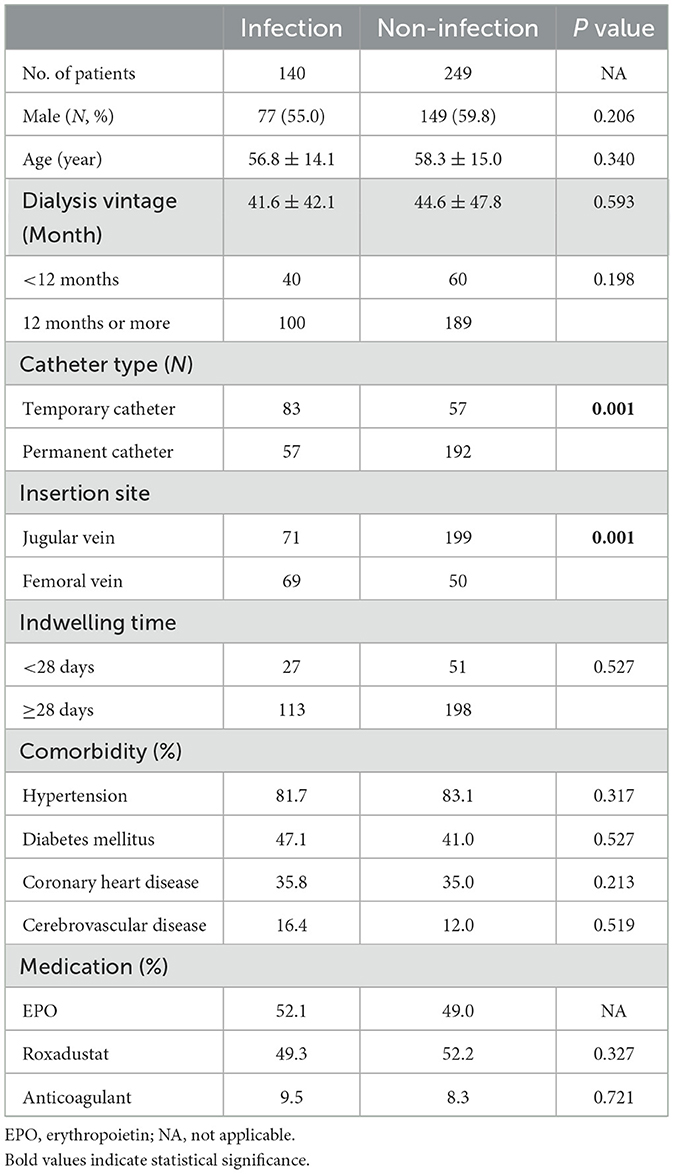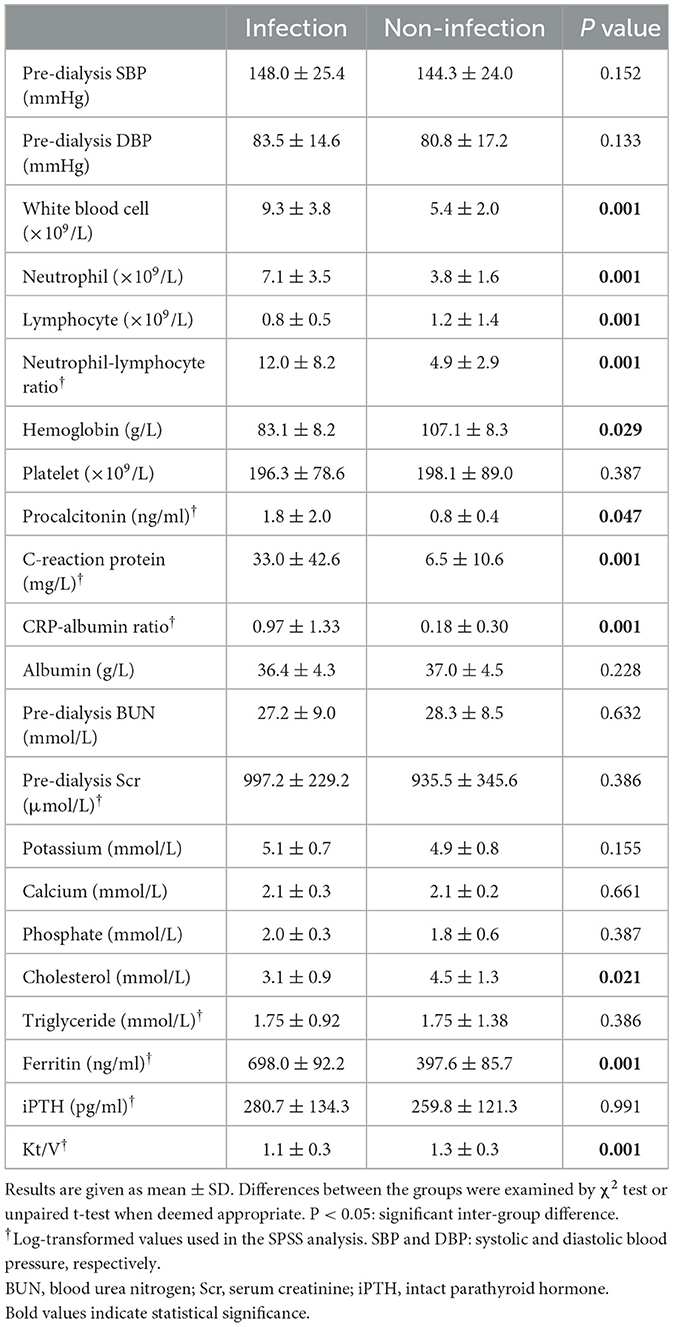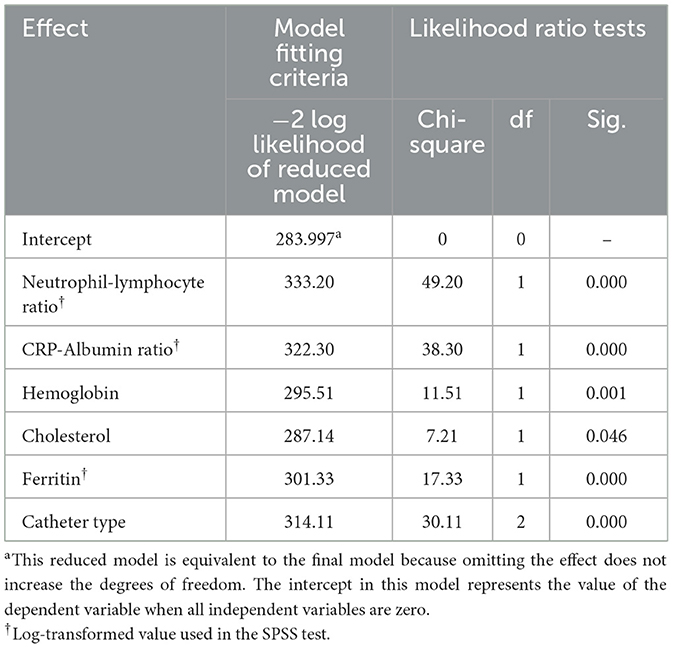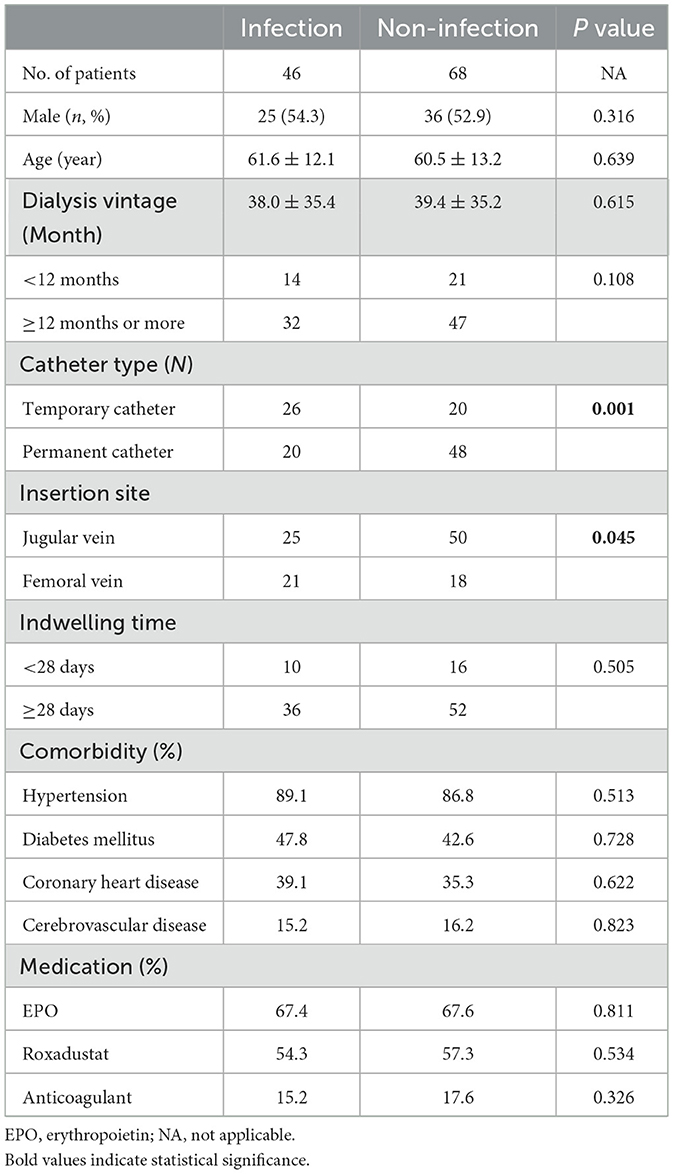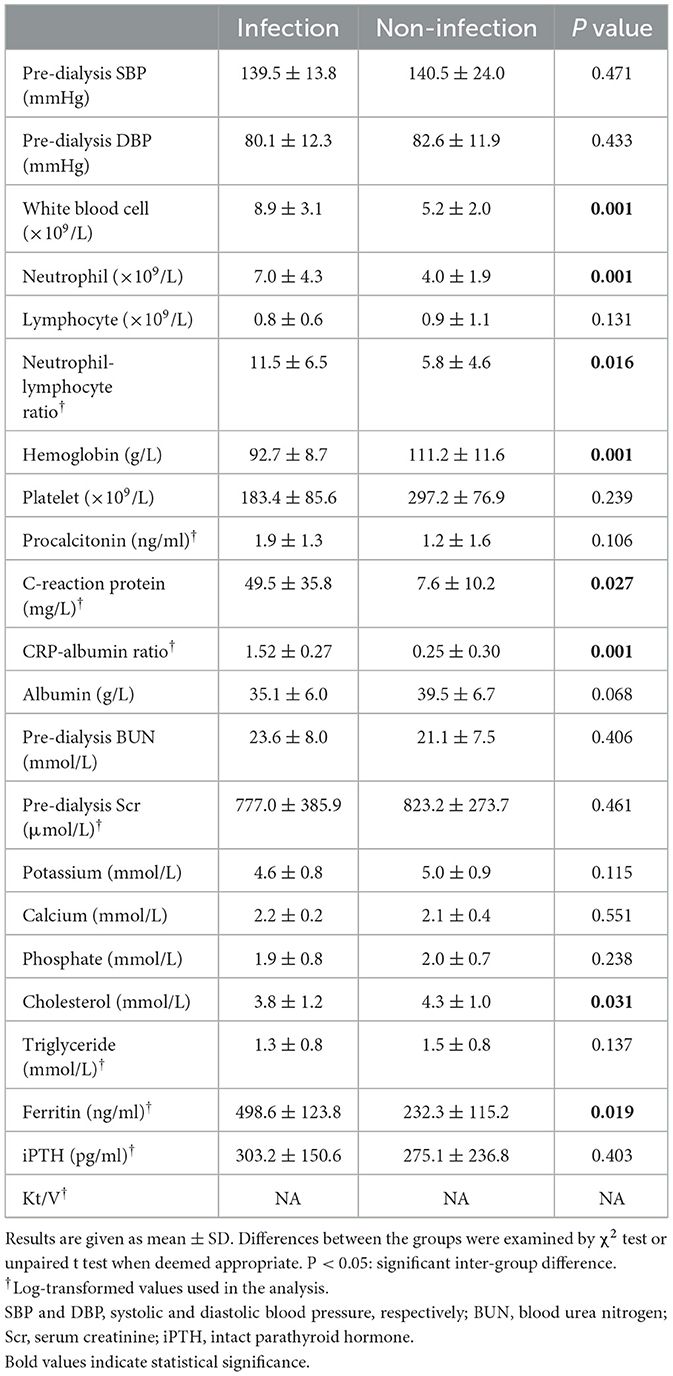- 1Graduate School of Hebei Medical University, Shijiazhuang, China
- 2Department of Nephrology, The First Hospital of Hebei Medical University, Shijiazhuang, China
- 3Department of Nephrology, The Second People's Hospital of Shenzhen, Shenzhen, China
- 4Department of Nephrology, Peking Union Medical College Hospital, Beijing, China
- 5Hemodialysis Center, The First Hospital of Hebei Medical University, Shijiazhuang, China
Background: An improved prediction method concurrently using neutrophil-to-lymphocyte ratio (NLR) and CRP-to-albumin ratio (CAR) was herein developed for catheter-related bloodstream infection (CRBSI), which is a potentially life-threatening complication in maintenance hemodialysis (MHD) patients.
Methods: In a multicenter retrospective cohort study, MHD patients using central venous catheter in the past 3 years were divided into infected and uninfected groups by the events of CRBSI. Inter-group difference was examined by either t-test or chi-square test. Positive findings were further stepwisely explored for independent effect, diagnostic efficacy and synergistic action on the CRBSI by binary logistic regression analysis, receiver operating characteristic (ROC) curve and multiple dimensionality reduction (MDR) method, respectively. Findings up to the ROC curve were separately validated in a second cohort, which was then incorporated for the testing of MDR method.
Results: Eligible patients with and without CRBSI were 140 and 249, respectively. Hemoglobin (Hb), NLR, CAR, cholesterol, ferritin, and catheter type showed major inter-group differences and their independent effect on the CRBSI was confirmed by the regression analysis. These findings were literally validated in the second cohort. The ROC curve subsequently yielded a cutoff value of 6.115 for the NLR and 0.345 for the CAR. Accordingly, patients simultaneously manifesting higher NLR and CAR had the utmost risk for CRBSI as confirmed by the MDR method and vice versa.
Conclusion: As such, NLR and CAR are inexpensive, replicable and easily measurable hematological indices for the prediction of future onset of CRBSI in asymptomatic patients, with better applicability and accuracy upon concurrent use.
Introduction
Infection is a well-recognized complication and the second leading cause of hospitalization and death in maintenance hemodialysis (MHD) patients (1, 2). In this regard, vascular access-related bloodstream infection (BSI) manifested 7.7 episodes per 100 patient-years, respectively rendering hospitalizations and mortality rate of 48.0 and 1.6% (3). In fact, majority of the above said BSI occurred in patients dialyzing with central vein catheter (CVC) (3). Centers for Disease Control and Prevention (CDC) had recognized this important clinical consequence and issued report to lower the infection rates, especially the catheter-related BSI (CRBSI) (4). However, CRBSI continued to occur at unacceptable rates in the United States, possibly because of additional factors not addressed by the CDC's core interventions (5). Hence, there is a clear need for a simple and easily measurable index to predict future onset of CRBSI in asymptomatic patients as part of the prophylactic measures.
Neutrophil-to-lymphocyte (NLR) is a surrogate marker of systemic inflammation and endothelial damage, and has been associated with adverse outcomes in a range of diseases (6). Previous studies have shown that NLR may predict early occurrence of nosocomial infection and infection-related hospitalization in patients with cirrhosis (7) and end stage renal disease (8), respectively. Moreover, a recent report highlighted the use of NLR in identifying and predicting complications associated with hemodialysis and peritoneal dialysis, including cardiovascular disease and infection (9). In addition, serum C-reactive protein (CRP)-to-albumin ratio (CAR) is also a well-known indicator of infection (10).
In this study, we started with the determination of prospective association between the above said ratios (NLR/CAR) and CRBSI in a cohort of Chinese MHD patients, and proceeded to validate the findings in a second cohort. Eventually, we wrapped up with configuring an improved prediction method by concurrently using the relevant ratios, with regard to having better applicability and accuracy.
Methods
Study design
This work was a multicenter consecutive retrospective cohort study and the lead investigation was carried out at the Department of Nephrology in the First Hospital of Hebei Medical University, with peer collaboration from two other major domestic hospitals. Data were retrieved from the medical charts of hemodialysis patients using CVCs (the exploration cohort) between June 2021 and May 2024. Within 6 months thereafter, the findings were used for post-hoc test of CRBSI in similar patients from a third hospital (the validation cohort). Demographic characteristics and clinical information including comorbidity and medications were collected. Hemodialytic catheters were placed at either the femoral vein (untunneled temporary ones) or external jugular vein (tunneled long-term ones) by the Seldinger technique. Specific operation procedures of the ultrasound-guided cannulation and aseptic measures had been described in details (11). Indwelling time was recorded since the catheters were left in place and divided into two data sets by whether it exceeded 28 days (12).
The subjects included our in-center MHD patients and those referred to us seeking treatment of CRSBI, repairment of displaced catheter cuff, angioplasty of central vein stenosis or removal of catheter upon a functionally accessible fistula. Of note, the referred patients with CRBSI were usually from primary care settings or dialysis clinics (especially in the low-resource regions). They were further divided into the infected and uninfected groups based on the CRBSI development within the above-mentioned study period.
Patient selection
Patients who met the following criteria were included: (i) aged >18 years with end stage renal diseases, (ii) regular hemodialysis for three times per week with a 4-h session each. Especially for the infection group: (iii) arrived within 24-h (in-center patients) or 48-h (referred patients) after indicatives of infection without the use of antibiotic, (iv) CRBSI diagnosed according to the relevant criteria issued by the US CDC (13): causative pathogen identified from peripheral blood and/or catheter tip, (v) absence of hypotension and complications such as serious cardiac, cerebral, or hepatic diseases. It should be specified that “indicatives of infection” were basically fever and/or chill according to the NNIS definition of CRBSI (14). Patients not compatible with these criteria were excluded.
Hemodialysis protocols
The dialysis prescription was made according to the KDIGO guidelines, as in our previous report (15). Anemia, hypertension and hyperphosphatemia were managed by standard protocols, whereas low molecular weight heparin was used for anticoagulation.
Laboratory tests
Venous blood including samples for culture was collected before an empirical antibiotic was given, which was usually within 1 h after hospital admission. Data of blood routine was acquired using Beckman Coulter cellular analysis system (Unicel DxH800, CA, USA). Plasma parameters were measured by using Beckman Coulter AU5800 automatic biochemical analyzer. Ferritin and intact parathyroid hormone (iPTH) were determined by Beckman Coulter automatic chemiluminescence immunoassay analyzer (UniCel DxI800). Kt/V of the hemodialysis was derived from the well-established KDOQI equation.
Identification of causative pathogens
Blood samples were taken from the “artery” hub of the CVC and a peripheral vein simultaneously for 10 ml each and inoculated separately into individual culture bottles. The bottles were then incubated in fully automated microbial ID/AST system (DL-96A, Zhuhai DL Biotech, China) at 37 °C for 5 days. Identification of all isolates was performed using the auxiliary DL ID/AST test card. In particular, the tip of a removed catheter was also cultured and metagenomics next generation sequencing was used in case of negative blood/tip culture.
Statistical analysis
Statistical analyses were performed using SPSS version 26.0 (SPSS, Chicago, IL, USA). All data used in the analysis were normally distributed as the significantly skewed ones were log-transformed. Student's t-test and the chi-square test were used for comparing continuous and categorical variables between groups, respectively. Binary logistic regression analysis was then used to examine the independent effect of NLR/CAR, if any, on the CRBSI with adjustment of potential confounding factors. The identified risk factors were further evaluated by the receiver operating characteristic (ROC) curve, which generated paired sensitivity/specificity ranking and the optimal one (cutoff value) was selected according to the Youden's index (16). Finally, interaction between risk factors that may influence the CRBSI was examined by the multifactor dimensionality reduction (MDR) method. Subjects are divided into high-and low-risk groups, using the individual cutoff value of risk factors, and the MDR method is able to detect significant inter-group difference through cross-validation and permutation testing (17). Of note, data from the exploration and validation cohorts were separately tested until the ROC curve, after which they were integrated into the MDR method. By identifying the most susceptible individuals through this method, prediction of future occurrence of infection could be accomplished, which has been effectively applied to the partitioning of our MHD patients during the COVID-19 pandemic (17). Two-sided P < 0.05 was considered statistically significant.
Results
There were 140 eligible hemodialysis patients with CRBSI and 249 without it in the exploration cohort during the study period. As shown in Table 1, the infection group had more use of temporary catheter and femoral venous approach. Otherwise, there was no inter-group difference in term of gender composition, age, dialysis vintage, indwelling time, comorbidity and medications. Clinical features of the two groups were further listed in Table 2 and the significantly different ones were white blood cell, NLR, hemoglobin (Hb), procalcitonin (PCT), C-reaction protein (CRP), CAR, cholesterol, ferritin, and Kt/V. The rest of clinical parameters showed no difference between the two groups. Independent effect of the parameters with significant inter-group difference on the CRBSI (short of insertion site) was tested by the multiple logistic regression analysis and results given in Table 3. Apparently, NLR, CAR, Hb, cholesterol, ferritin, and catheter type remained as significant determinants of the CRBSI.
Possible diagnostic efficacy of the NLR and CAR on CRBSI was evaluated by the ROC curve, using data of the exploration cohort. It subsequently yielded, in the order of sensitivity, specificity and area under curve, 0.707, 0.775, and 0.756 for the NLR, 0.750, 0.723, and 0.772 for the CAR. Accordingly, the cut-off value for NLR and CAR was 6.615 and 0.345, respectively.
In the context of causative pathogen, positive rates of blood culture for the peripheral vein and “artery” hub were 36.4 and 46.4%, in comparison of a 59.0% positive rate for the 122 removed catheter tips. Causative pathogens in “all negative” cases were nailed down by the mNGS technique. As such, the percentage of Gram positive and negative bacteria was 60.0 and 37.1%, respectively, in addition to 2.9% of fungus.
There were 46 hemodialysis patients with CRBSI and 68 without it in the validation cohort, with same inter-group difference in the general profiles (Table 4). Significantly different clinical features were similar to those in the exploration cohort, but with comparable lymphocyte count and PCT irrespective of the CRBSI (Table 5). Likewise, independent effect of the NLR, CAR, Hb, cholesterol, ferritin, and catheter type on the CRBSI was confirmed by the multiple logistic regression analysis (data not shown). Of note, 23 patients had a NLR ratio higher than 6.615 and 14 of them were in the infection group. This composition produced a sensitivity and specificity of 71.8 and 72.1%, respectively. As for the characteristics of CRBSI pathogens, positive rates of culture were 37.0%, 41.3% and 53.8% for samples taken from the peripheral vein, “artery” hub and 39 removed catheter tips, respectively. Percentage of Gram positive bacteria was 65.2% and the rest was Gram negative ones, with absence of fungus.
After data of the two cohorts were pooled together, the patients were ulteriorly divided into four subgroups using the cutoff values of NLR and CAR and subjected to the testing of MDR method. It was clear that patients simultaneously manifesting higher NLR and CAR had the utmost risk for CRBSI and vice versa (Figure 1).
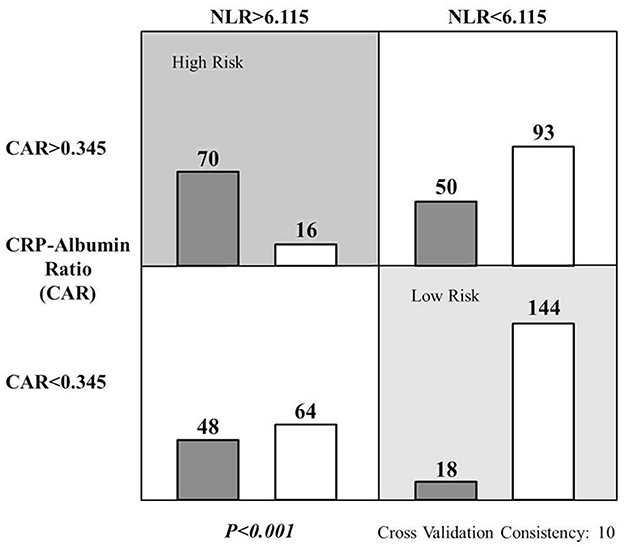
Figure 1. Significant interactive actions of the NLR and CAR on the risk of CRBSI in the studied MHD patients. Left and right bars in each cell represent patients with and without the CRBSI, respectively. Dark gray cell indicates higher risk of infection and the light gray one for lower risk.
Discussion
Today NLR is widely used across almost all medical disciplines as a reliable and easily applicable marker of immune response to various infectious and non-infectious stimuli. However, its application in the CRBSI among MHD patients has been sparsely explored. Likewise, this situation is also true for the CAR, with paucity of related reports. We in this work found a predictive role of NLR or CAR in the CRBSI, whereas concurrent use of these ratios was more accurate compared to a separate evaluation.
Conserved by evolution, neutrophilia and lymphocytopenia are acute dynamic changes that reflect the natural physiological response of circulating leukocytes to stress, injury, trauma, major surgery and infection (18). Neutrophils, although more numerous, are relatively hypofunctional and absolute lymphopenia is common during sepsis as highlighted in a latest work of the NEMJ (19). The NLR is hence the optimal expression of the balance between innate (neutrophil) and adaptive (lymphocyte) immune response, as it integrates information regarding these two distinct leukocyte subtypes. Indeed, the NLR has been shown to be significantly associated with inflammation and death (20), and can predict mortality in patients undergoing dialysis (21). A normal range of NLR is reportedly between 1.0 and 2.0 and the values higher than 3.53 and below 0.78 in adults are pathological (22), with a value above 11.7 significantly associated with mortality in COVID-19 infection (23). Determination of the NLR cut-off value was explicitly proposed in a study of infection and hemodialysis catheter survival (24), as such a value was essential for constructing management algorithms. Upon and beyond these understandings, we came up with not only a specific value, but also an algorithm, namely, a pragmatic method for predicting future onset of CRBSI prior to the clinical diagnosis.
We detected a positive correlation between NLR and CRBSI in MHD patients using multivariable regression. This correlation likely stemmed from the role of neutrophils and lymphocytes in the immune response: neutrophils are crucial in the initial defense against infections, while lymphocytes are involved in the adaptive immune response. An elevated NLR indicates a heightened inflammatory state, which is known to predispose patients to infection-related catheter exchange (24) or pneumonia in the MHD population (25). Reportedly, there is also a correlation between serum PCT concentration and NLR values in patients with infectious diseases (26), with NLR presumably having higher predictive efficiency than PCT in early sepsis (27). However, PCT is the predictor in a full-swing infection but not in an early one (28) and this may explain its absence of difference in the validation cohort. More realistically, whether protocol using PCT was generalizable to low-resource settings was recently questioned (29). On a practical level, a large portion of the patient population received long-term dialysis in local hospitals or clinics and it was in these settings that complications including the CRBSI occurred (30). Therefore, a straightforward and cost-effective biomarker with predictive attributes is needed in these primary care settings, especially the low-resource ones. A priori, these considerations qualified the NLR as an excellent one.
Yang et al. (31) has previously reported elevated NLR for the early diagnosis of CRBSI in MHD patients. Their work also yielded a cut-off value of 4.485 for NLR and 100% positive rate of peripheral blood culture. It was unusual to find that their conclusion was based on mere t-test between the infection and no-infection groups, without taking into account cofounding factors. In this regard, we are more inclined to trust the multivariate analysis as in our recent work establishing susceptibility model for COVID-19 infection in the MHD population (17). Secondly, a 100% positive rate of blood culture seemed far beyond our reach (32). Lee et al. (33) reported a positivity of 73.1 and 89.7% with the first blood culture and first two blood cultures, respectively, obtained during the 24-h period of bacteremia. As the last major divergence, predominant pathogen of CRBSI was Gram positive bacteria in our work, which was in agreement with currently known data (34).
While interpreting the relevance of NLR and CAR on CRBSI, it is important to consider the potential association between malnutrition and inflammation. Actually, malnutrition-inflammation-atherosclerosis (MIA) syndrome is an important issue in MHD patients as we have highlighted previously (15). Therefore, CAR is also a reliable risk indicator for inflammatory conditions as CRP and albumin are two major participants in the MIA syndrome. Consistently, our findings indicated that better management of Hb and cholesterol may predispose the MHD patients to lower risk of CRBSI, whereas higher ferritin levels act conversely. Obviously, anemia was associated with increased risk for CRBSI (35) and we have specified in MHD patients the role of cholesterol as a surrogate marker for nutrition (15) and participation of iron load in infection elsewhere (17, 32). The fact that long-term catheter is more resistance to CRSBI than the temporary ones is beyond all doubt (36). Finally, these major findings were confirmed in the validation cohort.
Admittedly, a single clinical variable may not be sufficient to accurately predict CRBSI. This is why we tried to configure the NLR and CAR in a role that maximum their efficacy, a task relied heavily on the MDR method. By nature, this method is a multivariate non-parametric approach that helps to simultaneously detect and characterize multiple genetic loci (designated as factor in the MDR) associated with a discrete clinical end-point. By design, effect of the factors was simplified into a “binary” way, which in turn abrogates possible interference among them. By function, this method made it possible for the analysis of small number of samples when traditional methods cannot be applied (37). By practice, performance of the MDR method in skewed distributions was superior to several current methodologies (38), including the principle component analysis which is the backbone of dimensionality reduction in SPSS (39). Taken together, the MDR method is a trustworthy tool regardless of the correlations between factors, the sample size and data distribution. In our current work, subjects were partitioned by the cutoff values of NLR and CAR (assigned as presumed “factors”), their CRBSI status presented in binary format and possible high-order interaction between these two variables successfully tested (Figure 1). Evidently, the MDR-based stratification may contribute to the clinical decision-making as a triage tool (17). As such, interventions of the CDC's collaborative prevention program (5) could be implemented more pointedly and efficaciously.
There are still some limitations in our work concerning its retrospective design, dynamic changes in NLR/CAR and our single calculation of the optimal cut-off value of NLR in a cohort with limited patient number. Otherwise, a subgroup analysis by the type of causative pathogens would have been performed for a better understanding of the predictive value of NLR and CAR in different types of CRBSI. Indeed, NLR is useful to discriminate infections caused by fungus from Gram positive bacteria in febrile patients with BSI, whereas IL-6 could break the G+ group from G− one in these patients (40). Further work focusing on NLR, CAR, and cytokines in a prospective way and with multicenter collaboration has been undertaken accordingly.
Conclusions
NLR is a dynamic parameter with a quick response to infections and it may reflect development of the CRBSI in the MHD patients. Combination of the NLR with CAR may further mitigate its diagnostic limitations and provide more precise information on CRBSI. Arguably, these findings emphasized the importance of identifying high-risk patients who may benefit from early therapeutic interventions.
Data availability statement
The raw data supporting the conclusions of this article will be made available by the authors, without undue reservation.
Ethics statement
The studies involving humans were approved by Ethical Committee of the First Hospital of Hebei Medical University. The studies were conducted in accordance with the local legislation and institutional requirements. The human samples used in this study were acquired from a by-product of routine care or industry. Written informed consent for participation was not required from the participants or the participants' legal guardians/next of kin in accordance with the national legislation and institutional requirements.
Author contributions
ZZ: Data curation, Investigation, Writing – original draft. SY: Formal analysis, Writing – original draft. XZ: Investigation, Validation, Writing – review & editing. HL: Methodology, Writing – review & editing. XL: Writing – original draft, Project administration. LZ: Writing – original draft, Supervision. TW: Writing – review & editing, Conceptualization, Methodology, Funding acquisition.
Funding
The author(s) declare that financial support was received for the research and/or publication of this article. This study was supported by the Research Project for Medical Science of Hebei Provincial Health Commission (20250402) and 2025 Hebei Provincial Government-funded Excellent Talents Project for Clinical Medicine (ZF2025060).
Conflict of interest
The authors declare that the research was conducted in the absence of any commercial or financial relationships that could be construed as a potential conflict of interest.
Generative AI statement
The author(s) declare that no Gen AI was used in the creation of this manuscript.
Any alternative text (alt text) provided alongside figures in this article has been generated by Frontiers with the support of artificial intelligence and reasonable efforts have been made to ensure accuracy, including review by the authors wherever possible. If you identify any issues, please contact us.
Publisher's note
All claims expressed in this article are solely those of the authors and do not necessarily represent those of their affiliated organizations, or those of the publisher, the editors and the reviewers. Any product that may be evaluated in this article, or claim that may be made by its manufacturer, is not guaranteed or endorsed by the publisher.
References
1. Chavers BM, Solid CA, Gilbertson DT, Collins AJ. Infection-related hospitalization rates in pediatric versus adult patients with end-stage renal disease in the United States. J Am Soc Nephrol. (2007) 18:952–9. doi: 10.1681/ASN.2006040406
2. Moroi M, Tamaki N, Nishimura M, Haze K, Nishimura T, Kusano E, et al. Association between abnormal myocardial fatty acid metabolism and cardiac-derived death among patients undergoing hemodialysis: results from a cohort study in Japan. Am J Kidney Dis. (2013) 61:466–75. doi: 10.1053/j.ajkd.2012.09.017
3. Nguyen DB, Shugart A, Lines C, Shah AB, Edwards J, Pollock D, et al. National Healthcare Safety Network (NHSN) Dialysis Event Surveillance Report for 2014. Clin J Am Soc Nephrol. (2017) 12:1139–46. doi: 10.2215/CJN.11411116
4. Rha B, See I, Dunham L, Kutty PK, Moccia L, Apata IW, et al. Vital signs: health disparities in hemodialysis-associated staphylococcus aureus bloodstream infections-United States, 2017-2020. MMWR Morb Mortal Wkly Rep. (2023) 72:153–9. doi: 10.15585/mmwr.mm7206e1
5. Fisher M, Golestaneh L, Allon M, Abreo K, Mokrzycki MH. Prevention of bloodstream infections in patients undergoing hemodialysis. Clin J Am Soc Nephrol. (2020) 15:132–51. doi: 10.2215/CJN.06820619
6. Valga F, Monzón T, Henriquez F, Antón-Pérez G. Neutrophil-to-lymphocyte and platelet-to-lymphocyte ratios as biological markers of interest in kidney disease. Nefrologia. (2019) 39:243–9. doi: 10.1016/j.nefro.2018.11.005
7. Cai YJ, Dong JJ, Dong JZ, Yang NB, Song M, Wang YQ, et al. Neutrophil-lymphocyte ratio predicts hospital-acquired bacterial infections in decompensated cirrhosis. Clin Chim Acta. (2017) 469:201–7. doi: 10.1016/j.cca.2017.04.011
8. He T, Wu Y, Li X, Yang M, Lin Q. Risk factors for infection-related hospitalization in end-stage renal disease patients during peri-dialysis period. Ther Apher Dial. (2022) 26:717–25. doi: 10.1111/1744-9987.13753
9. Yang N, Yang K, Pan S, He Q, Jin J. Progress in the application of the neutrophil-to-lymphocyte ratio in dialysis-related complications. Ren Fail. (2023) 45:2259996. doi: 10.1080/0886022X.2023.2259996
10. Kunutsor SK, Laukkanen JA. Serum C-reactive protein-to-albumin ratio is a potential risk indicator for pneumonia: findings from a prospective cohort study. Respir Med. (2022) 199:106894. doi: 10.1016/j.rmed.2022.106894
11. Becerra-Bolaños Á, Domínguez-Díaz Y, Trujillo-Morales H, Cabrera-Doreste S, Padrón-Ruiz O, Valencia-Sola L, et al. Assessing infection related to short-term central venous catheters in the perioperative setting. Sci Rep. (2025) 15:1642. doi: 10.1038/s41598-025-85836-z
12. de Andrade D, Ferreira V. Central venous access for haemodialysis: prospective evaluation of possible complications. J Clin Nurs. (2007) 16:414–8. doi: 10.1111/j.1365-2702.2006.01654.x
13. Centers for Disease Control and Prevention (CDC). Vital signs: central line-associated blood stream infections–United States, 2001, 2008, and 2009. MMWR Morb Mortal Wkly Rep. (2011) 60:243–8.
14. Pronovost P, Needham D, Berenholtz S, Sinopoli D, Chu H, Cosgrove S, et al. An intervention to decrease catheter-related bloodstream infections in the ICU [published correction appears in N Engl J Med. (2007) 356(25):2660]. N Engl J Med. (2006) 355:2725–32. doi: 10.1056/NEJMoa061115
15. Wang T, Li Y, Wu H, Chen H, Zhang Y, Zhou H, et al. Optimal blood pressure for the minimum all-cause mortality in Chinese ESRD patients on maintenance hemodialysis. Biosci Rep. (2020) 40:BSR20200858. doi: 10.1042/BSR20200858
16. Ivanes F, Isorni MA, Halimi JM, Fauchier L, Saint Etienne C, Babuty D, et al. Predictive factors of contrast-induced nephropathy in patients undergoing primary coronary angioplasty. Arch Cardiovasc Dis. (2014) 107:424–32. doi: 10.1016/j.acvd.2014.05.008
17. Yuan S, Meng F, Zhou S, Liu X, Liu X, Zhang L, et al. Predicting susceptibility to COVID-19 infection in patients on maintenance hemodialysis by cross-coupling soluble ACE2 concentration with lymphocyte count: an algorithmic approach. Front Med. (2024) 11:1444719. doi: 10.3389/fmed.2024.1444719
18. Zahorec R. Neutrophil-to-lymphocyte ratio. Sixteen-year-long history since publication of our article in Bratislava Medical Journal. Bratisl Lek Listy. (2017) 118:321–3. doi: 10.4149/BLL_2017_062
19. Nuala J, Meyer JN, Prescott CH. Sepsis and septic shock. N Engl J Med. (2024) 391:2133–46. doi: 10.1056/NEJMra2403213
20. Song M, Graubard BI, Rabkin CS, Engels EA. Neutrophil-to-lymphocyte ratio and mortality in the United States general population. Sci Rep. (2021) 11:464. doi: 10.1038/s41598-020-79431-7
21. Catabay C, Obi Y, Streja E, Soohoo M, Park C, Rhee CM, et al. Lymphocyte cell ratios and mortality among incident hemodialysis patients. Am J Nephrol. (2017) 46:408–16. doi: 10.1159/000484177
22. Forget P, Khalifa C, Defour JP, Latinne D, Van Pel MC, De Kock M. What is the normal value of the neutrophil-to-lymphocyte ratio? BMC Res Notes. (2017) 10:12. doi: 10.1186/s13104-016-2335-5
23. Yan X, Li F, Wang X, Yan J, Zhu F, Tang S, et al. Neutrophil to lymphocyte ratio as prognostic and predictive factor in patients with coronavirus disease 2019: a retrospective cross-sectional study. J Med Virol. (2020) 92:2573–81.
24. Baykara Ulusan M, Meltem E, Mutlu IN, Ulusan K. The predictive value of systemic inflammatory markers in 902 patients with tunneled hemodialysis catheter. J Nephrol. (2024) 37:1041–9. doi: 10.1007/s40620-023-01880-w
25. Yan L, Qiu Y, Liu J, Wu J, Yang J, He W. Increased thoracic fluid content is associated with higher risk for pneumonia in patients undergoing maintenance hemodialysis. Ren Fail. (2023) 45:2207666. doi: 10.1080/0886022X.2023.2207666
26. Gürol G, Çiftci IH, Terizi HA, Atasoy AR, Ozbek A. Köroglu M. Are there standardized cutoff values for neutrophil-lymphocyte ratios in bacteremia or sepsis? J Microbiol Biotechnol. (2015) 25:521–5. doi: 10.4014/jmb.1408.08060
27. Wu H, Cao T, Ji T, Luo Y, Huang J, Ma K. Predictive value of the neutrophil-to-lymphocyte ratio in the prognosis and risk of death for adult sepsis patients: a meta-analysis. Front Immunol. (2024) 15:1336456. doi: 10.3389/fimmu.2024.1336456
28. Shokripour M, Omidifar N, Salami K, Moghadami M, Samizadeh B. Diagnostic accuracy of immunologic biomarkers for accurate diagnosis of bloodstream infection in patients with malignancy: procalcitonin in comparison with C-reactive protein. Can J Infect Dis Med Microbiol. (2020) 2020:8362109. doi: 10.1155/2020/8362109
29. Dark P, Hossain A, McAuley DF, Brealey D, Carlson G, Clayton JC, et al. Biomarker-guided antibiotic duration for hospitalized patients with suspected sepsis: the ADAPT-sepsis randomized clinical trial. JAMA. (2025) 333:682–93. doi: 10.1001/jama.2024.26458
30. de Rooij ENM, Meuleman Y, de Fijter JW, Jager KJ, Chesnaye NC, Evans M, et al. Symptom burden before and after dialysis initiation in older patients. Clin J Am Soc Nephrol. (2022) 17:1719–29. doi: 10.2215/CJN.09190822
31. Yang J, Wang H, Hua Q, Wu J, Wang Y. Diagnostic value of systemic inflammatory response index for catheter-related bloodstream infection in patients undergoing haemodialysis. J Immunol Res. (2022) 2022:7453354. doi: 10.1155/2022/7453354
32. Zhou S, Ren G, Liu Y, Liu X, Zhang L, Xu S, et al. Challenge of evolving Klebsiella pneumoniae infection in patients on hemodialysis: from the classic strain to the carbapenem-resistant hypervirulent one. Int J Med Sci. (2022) 19:416–24. doi: 10.7150/ijms.69577
33. Lee A, Mirrett S, Reller LB, Weinstein MP. Detection of bloodstream infections in adults: how many blood cultures are needed? J Clin Microbiol. (2007) 45:3546–48. doi: 10.1128/JCM.01555-07
34. Li PK, Chow KM. Infectious complications in dialysis-epidemiology and outcomes. Nat Rev Nephrol. (2011) 8:77–88. doi: 10.1038/nrneph.2011.194
35. Bitunguramye A, Nkundimana G, Aboubasha AM, Kabahizi J, Rutikanga W, Nshimiyimana L, et al. Incidence, risk factors, organism types, and outcomes of catheter-related bloodstream infections in hemodialysis patients. Cureus. (2024) 16:e69554. doi: 10.7759/cureus.69554
36. Guo H, Zhang L, He H, Wang L. Risk factors for catheter-associated bloodstream infection in hemodialysis patients: a meta-analysis. PLoS ONE. (2024) 19:e0299715. doi: 10.1371/journal.pone.0299715
37. Ritchie MD, Hahn LW, Roodi N, Bailey LR, Dupont WD, Parl FF, et al. Multifactor-dimensionality reduction reveals high-order interactions among estrogen-metabolism genes in sporadic breast cancer. Am J Hum Genet. (2001) 69:138–47. doi: 10.1086/321276
38. Park M, Jeong HB, Lee JH, Park T. Spatial rank-based multifactor dimensionality reduction to detect gene-gene interactions for multivariate phenotypes. BMC Bioinformat. (2021) 22:480. doi: 10.1186/s12859-021-04395-y
39. Liu RX, Kuang J, Gong Q, Hou XL. Principal component regression analysis with SPSS. Comput Methods Prog Biomed. (2003) 71:141–7. doi: 10.1016/S0169-2607(02)00058-5
Keywords: maintenance hemodialysis, neutrophil-to-lymphocyte ratio, CRP-to-albumin ratio, catheter-related bloodstream infection, central venous catheter
Citation: Zhao Z, Yuan S, Zhang X, Li H, Liu X, Zhang L and Wang T (2025) Neutrophil-to-lymphocyte ratio and CRP-to-albumin ratio in the prediction of catheter-related bloodstream infection among maintenance hemodialysis patients: a synergistical optimization algorithm. Front. Med. 12:1612057. doi: 10.3389/fmed.2025.1612057
Received: 15 April 2025; Accepted: 11 August 2025;
Published: 04 September 2025.
Edited by:
Hitoshi Suzuki, Juntendo University Urayasu Hospital, JapanCopyright © 2025 Zhao, Yuan, Zhang, Li, Liu, Zhang and Wang. This is an open-access article distributed under the terms of the Creative Commons Attribution License (CC BY). The use, distribution or reproduction in other forums is permitted, provided the original author(s) and the copyright owner(s) are credited and that the original publication in this journal is cited, in accordance with accepted academic practice. No use, distribution or reproduction is permitted which does not comply with these terms.
*Correspondence: Tao Wang, d2FuZ2FvLVBJQGhlYm11LmVkdS5jbg==
†These authors have contributed equally to this work and share first authorship
‡ORCID: Tao Wang orcid.org/0000-0002-7370-7299
 ZhiPeng Zhao1,2†
ZhiPeng Zhao1,2† XiuLi Zhang
XiuLi Zhang Tao Wang
Tao Wang